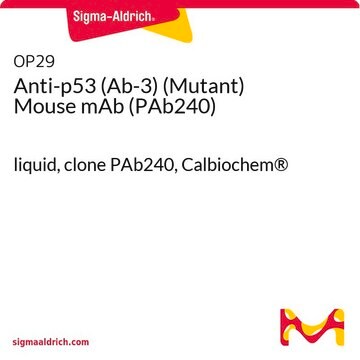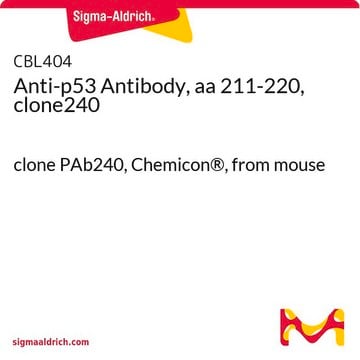MABE327
Anti-p53 (pantropic) Antibody, clone DO-1
clone DO-1, from mouse
Sinónimos:
Cellular tumor antigen p53, Antigen NY-CO-13, Phosphoprotein p53, Tumor suppressor p53
About This Item
Productos recomendados
biological source
mouse
Quality Level
antibody form
purified immunoglobulin
antibody product type
primary antibodies
clone
DO-1, monoclonal
species reactivity
human
technique(s)
immunocytochemistry: suitable
immunofluorescence: suitable
immunohistochemistry: suitable
immunoprecipitation (IP): suitable
western blot: suitable
isotype
IgG2aκ
NCBI accession no.
UniProt accession no.
shipped in
wet ice
target post-translational modification
unmodified
Gene Information
human ... TP53(7157)
General description
Specificity
Immunogen
Application
Immunohistochemistry Analysis: A 1:1,000 dilution from a representative lot detected p53 (pantropic) in human colorectal adenocarcinoma tissue and in human prostate cancer tissue.
Immunofluorescence Analysis: A 1:1,000 dilution from a representative lot detected p53 (pantropic) in human colorectal cancer cells.
Immunoprecipitation Analysis: A representative lot was used by an independent laboratory in radiolabelled HOS cell lysate (Vojtesek, B., et al. (1995). 71(6):1253-1256.).
Immunohistochemistry Analysis: A representative lot was used by an independent laboratory in primary breast carcinoma tissue (Beck, T., et al. (1995). Gynecol Oncol. 57(1):96-104.).
Epigenetics & Nuclear Function
Cell Cycle, DNA Replication & Repair
Quality
Western Blot Analysis: 1 µg/mL of this antibody detected p53 (pantropic) in 10 µg of A431 cell lysate. This antibody detects isoforms 1, 2, and 3.
Target description
Linkage
Physical form
Storage and Stability
Analysis Note
A431 cell lysate
Other Notes
Disclaimer
Not finding the right product?
Try our Herramienta de selección de productos.
Optional
Storage Class
12 - Non Combustible Liquids
wgk_germany
WGK 1
flash_point_f
Not applicable
flash_point_c
Not applicable
Certificados de análisis (COA)
Busque Certificados de análisis (COA) introduciendo el número de lote del producto. Los números de lote se encuentran en la etiqueta del producto después de las palabras «Lot» o «Batch»
¿Ya tiene este producto?
Encuentre la documentación para los productos que ha comprado recientemente en la Biblioteca de documentos.
Nuestro equipo de científicos tiene experiencia en todas las áreas de investigación: Ciencias de la vida, Ciencia de los materiales, Síntesis química, Cromatografía, Analítica y muchas otras.
Póngase en contacto con el Servicio técnico








